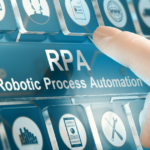What is robotic process automation in healthcare?
The healthcare industry is burdened with extensive administrative tasks that significantly impact efficiency and drive up costs. Healthcare professionals frequently spend a considerable amount of time on paperwork, data entry, and regulatory compliance, detracting from their primary focus on patient care. These administrative burdens contribute to inefficiencies, increase operational costs, and heighten the risk of errors, potentially affecting patient outcomes.
In an era where healthcare systems face constant pressure to enhance efficiency and reduce costs, innovative solutions are crucial. Robotic Process Automation-RPA in healthcare emerges as a promising solution, offering the potential to revolutionize administrative processes in healthcare. By automating repetitive and time-consuming tasks, RPA can help healthcare organizations improve operational efficiency, reduce costs, and elevate the quality of patient care.
I. What is robotic process automation (RPA)?
Robotic Process Automation (RPA) is a technology that employs software robots, or “bots,” to replicate human actions within digital systems. These bots can interact with various applications, manipulate data, trigger responses, and communicate with other systems to perform a wide range of repetitive tasks. Unlike traditional automation tools, RPA is designed to operate across different software platforms without extensive integration efforts.
The primary benefits of RPA for businesses include improved accuracy, reduced errors, and increased productivity. By automating routine tasks, organizations can minimize human errors that often occur with manual data entry and processing. Additionally, RPA enables businesses to execute processes faster and more efficiently, leading to significant productivity gains. These advantages make RPA an attractive solution for industries heavily reliant on data processing and administrative tasks, including healthcare.
II. How Does Robotic Process Automation (RPA) Work?
RPA operates through a series of steps that involve task identification, bot configuration, and system integration. The process automation begins with identifying tasks suitable for automation. These tasks are typically repetitive, rule-based, and time-consuming, such as data entry, invoice processing, and report generation.
Once tasks are identified, the next step is configuring the bots. This involves programming the bots to execute the desired actions using a set of predefined rules and workflows. The configuration process can be done through a visual interface, enabling non-technical users to create and manage bots without extensive programming knowledge.
RPA solutions can be categorized into two main types: attended and unattended RPA. Attended RPA bots work alongside human employees and are triggered by specific user actions. These bots are ideal for tasks requiring human intervention, such as customer service interactions. Unattended RPA bots, on the other hand, operate independently and can perform tasks without human intervention. These bots are suitable for back-office operations, such as data processing and batch processing.
III. Application of Robotic Process Automation (RPA) in Healthcare
RPA has a wide range of applications in healthcare, where it can streamline various workflows and improve efficiency. Here are some specific areas where RPA can be used and make a significant impact:
a. Administrative Tasks
Administrative tasks in healthcare are often repetitive and time-consuming, detracting from patient care and contributing to staff burnout. RPA can significantly alleviate this burden by automating tasks such as data entry, appointment scheduling, and report generation.
i. Data Entry:
RPA for healthcare can automate the entry of patient information into Electronic Health Records (EHRs), reducing the time and effort required for manual data entry. This includes inputting patient demographics, medical histories, and insurance details. By automating data entry, healthcare organizations can ensure greater accuracy and consistency in patient records, which is crucial for delivering quality care and making informed decisions.
ii. Appointment Scheduling:
Bots can handle appointment scheduling by managing calendars, sending reminders to patients, and updating schedules in real time. This reduces the administrative burden on staff and minimizes the risk of scheduling errors. Automating appointment scheduling can also improve patient satisfaction by reducing wait times and ensuring that appointments are efficiently managed.
iii. Report Generation:
RPA can automate the generation of various reports, including patient discharge summaries, billing reports, and compliance reports. This ensures timely and accurate reporting while freeing up staff for more critical tasks. Automated report generation can also facilitate better decision-making and improve the overall efficiency of healthcare operations.
b. Revenue Cycle Management
Revenue cycle management (RCM) is a critical aspect of healthcare operations, involving the management of administrative and clinical functions associated with claims processing, payment, and revenue generation. RPA can streamline several RCM processes, leading to faster and more accurate transactions.
i. Claim Adjudication:
Bots can automate the adjudication of insurance claims by verifying patient information, checking coverage details, and processing claims according to predefined rules. This accelerates the claims process and reduces the likelihood of errors. Automated claim adjudication ensures that claims are processed efficiently, reducing the time it takes for healthcare providers to receive payment.
ii. Insurance Verification:
RPA can verify patient insurance coverage by accessing insurance portals and retrieving the necessary information. This ensures that patients are eligible for the services they receive and reduces claim denials. By automating insurance verification, healthcare organizations can improve the accuracy of insurance information and reduce administrative delays.
iii. Prior Authorization Requests:
Bots can manage prior authorization requests by submitting the necessary documentation to insurance companies and following up on the approval process. This speeds up the authorization process and ensures timely patient care. Automating prior authorization requests can reduce administrative burden and improve the efficiency of healthcare delivery.
c. Patient Care
RPA for healthcare can also enhance patient care by automating tasks that directly impact the patient experience and clinical outcomes. This includes prescription management, referral management, and data integration with EHRs.
i. Prescription Management:

RPA can automate the prescription management process by generating electronic prescriptions, checking for drug interactions, and sending prescriptions to pharmacies. This reduces the administrative workload on healthcare providers and enhances patient safety. Automated prescription management ensures that prescriptions are processed accurately and efficiently, reducing the risk of medication errors.
ii. Referral Management:
Bots can handle the referral process by identifying appropriate specialists, sending referral requests, and tracking the status of referrals. This ensures that patients receive timely and coordinated care. Automating referral management can improve the efficiency of the referral process and ensure that patients receive the care they need without unnecessary delays.
iii. Data Integration with EHR:
RPA can facilitate the integration of data from various sources into EHR systems, ensuring that healthcare providers have access to comprehensive and up-to-date patient information. This improves the quality of care and supports informed decision-making.
IV. Compliance of RPA for healthcare
Compliance with regulatory requirements is a critical aspect of healthcare operations. RPA can help healthcare organizations ensure compliance with data security, audit trail management, and regulatory reporting requirements.
a. Data Security:
RPA can enhance data security by automating access controls, monitoring user activities, and ensuring compliance with data protection regulations. This helps healthcare organizations safeguard patient information and prevent data breaches. Automated data security measures can also reduce the risk of human error and ensure that sensitive information is protected.
b. Audit Trail Management:
Bots can create and maintain detailed audit trails of all activities performed within healthcare systems. This supports compliance with regulatory requirements and facilitates audits and investigations. By automating audit trail management, healthcare organizations can ensure that all activities are accurately recorded and easily retrievable.
c. Regulatory Reporting:
RPA can automate the generation and submission of regulatory reports, such as those required for HIPAA and ICD-10 compliance. This ensures timely and accurate reporting while reducing the administrative burden on staff. Automated regulatory reporting can also improve the accuracy and consistency of reports, reducing the risk of non-compliance.
V. Benefits of RPA for Healthcare
The implementation of RPA in healthcare offers numerous benefits for healthcare providers, including:
a. Improved Efficiency and Productivity
By automating routine tasks, RPA frees up healthcare staff to focus on higher-value activities, such as patient care and clinical decision-making. This leads to increased productivity and improved efficiency across healthcare organizations. Automating repetitive tasks also reduces the time and effort required for administrative processes, allowing healthcare providers to allocate resources more effectively.
b. Reduced Errors and Improved Data Accuracy
RPA minimizes the risk of human errors in data entry and processing, ensuring that patient information and other critical data are accurate and reliable. This enhances the quality of care and reduces the potential for errors that could impact patient safety. Automated data entry and processing also improve the consistency and reliability of information, reducing the risk of discrepancies and inaccuracies.
c. Increased Staff Productivity for Higher-Value Tasks
With RPA handling repetitive and time-consuming tasks, healthcare staff can allocate more time to patient-centered activities and other high-priority tasks. This improves job satisfaction and allows healthcare providers to deliver better patient care. Automating administrative tasks also reduces the workload on staff, allowing them to focus on more complex and value-added activities.
d. Enhanced Patient Experience Through Faster Processes
RPA enables healthcare organizations to streamline processes and reduce wait times for patients. This includes faster appointment scheduling, quicker prescription management, and more efficient claim processing, all of which contribute to an improved patient experience. By automating these processes, healthcare organizations can ensure that patients receive timely and efficient care, improving overall satisfaction.
e. Reduced Operational Costs
By automating administrative tasks, healthcare organizations can reduce labor costs and operational expenses. RPA also reduces the need for additional staff to handle peak workloads, leading to significant cost savings. Automating tasks also reduces the risk of errors and rework, further reducing operational costs and improving efficiency.
f. Improved Regulatory Compliance
RPA ensures that healthcare organizations adhere to regulatory requirements by automating compliance-related tasks. This includes maintaining accurate records, generating timely reports, and creating audit trails, all of which support regulatory compliance and reduce the risk of penalties. Automated compliance measures also improve the accuracy and consistency of reports, reducing the risk of non-compliance and ensuring that healthcare organizations meet regulatory requirements.
VI. Challenges and Considerations
Despite the numerous benefits of RPA, healthcare organizations may face several challenges during implementation:
a. Upfront Costs
Implementing RPA requires an initial investment in software, infrastructure, and training. While the long-term benefits can outweigh the costs, healthcare organizations need to consider their budget and financial constraints when planning for RPA adoption. Conducting a thorough cost-benefit analysis can help organizations assess the potential return on investment and make informed decisions about RPA implementation.
b. Change Management
Introducing RPA in the healthcare industry can lead to changes in workflows and job roles, which may be met with resistance from staff. Effective change management strategies, including clear communication, training, and stakeholder engagement, are essential to ensure a smooth transition. Engaging staff and stakeholders early in the process can help address concerns and ensure that everyone is on board with the changes.
c. Data Security
RPA for healthcare involves accessing and processing sensitive patient information, which raises concerns about data security and privacy. Healthcare organizations must implement robust security measures to protect patient data and comply with data protection regulations. This includes ensuring that bots are securely configured and monitored, and that access controls are in place to prevent unauthorized access.
d. Ethical Considerations
The implementation of RPA for healthcare raises ethical considerations, particularly regarding job displacement. As RPA automates routine tasks, there is a concern that some roles may become redundant, leading to job losses. Healthcare organizations must address these concerns by providing training and up-skilling opportunities for staff to transition to new roles. Additionally, responsible data management practices are crucial to ensure patient privacy and maintain trust in automated systems.
VII. Tips for Successful Adoption of Robotic Process Automation in Healthcare
To ensure successful implementation of RPA for healthcare, organizations should consider the following tips:
a. Clear ROI Analysis:
Conduct a thorough return on investment (ROI) analysis to assess the potential benefits and costs of RPA. This will help organizations make informed decisions and justify the investment. A clear ROI analysis can also help organizations prioritize which tasks to automate and allocate resources more effectively.
b. Proper Planning:
Develop a comprehensive implementation plan that includes task identification, bot configuration, testing, and deployment. Proper planning ensures that RPA projects are executed efficiently and effectively. This includes identifying which tasks are suitable for automation, defining the rules and workflows for bots, and ensuring that bots are thoroughly tested before deployment.
c. Selecting the Right Vendor:
Choose a reputable RPA vendor with experience in the healthcare industry. The right vendor can provide the necessary tools, support, and expertise to ensure successful implementation. Selecting the right vendor can also help healthcare organizations navigate the complexities of RPA implementation and ensure that they receive the necessary support and training.
Frequently Asked Questions Robotic Process Automation At Health Care
1. What is Robotic Process Automation (RPA) and how is it used in healthcare?
Robotic Process Automation (RPA) is a technology that uses software robots or “bots” to mimic human actions on digital systems. These bots can automate repetitive and rule-based tasks across various applications, improving efficiency and accuracy. In healthcare, RPA can automate administrative tasks such as data entry, appointment scheduling, claims processing, and compliance reporting. By doing so, RPA helps reduce the administrative burden on healthcare staff, allowing them to focus more on patient care and improving overall operational efficiency.
2. What are the benefits of implementing RPA for healthcare organizations?
Implementing RPA in a healthcare organization offers several benefits:
- Improved Efficiency and Productivity: Automates routine tasks, freeing up staff to focus on higher-value activities.
- Reduced Errors and Improved Data Accuracy: Minimizes human errors in data entry and processing, ensuring more reliable information.
- Increased Staff Productivity: Allows healthcare staff to allocate more time to patient-centered tasks.
- Enhanced Patient Experience: Streamlines processes such as appointment scheduling and claims processing, reducing wait times and improving service delivery.
- Reduced Operational Costs: Lowers labor costs and operational expenses by automating repetitive tasks.
- Improved Regulatory Compliance: Ensures adherence to regulatory requirements through automated compliance-related tasks.
3. What challenges might healthcare organizations face when implementing RPA, and how can they be addressed?
Healthcare organizations may encounter several challenges when implementing RPA:
- Upfront Costs: Initial investment in RPA software, infrastructure, and training can be substantial. Conducting a thorough cost-benefit analysis helps justify the investment and plan the budget effectively.
- Change Management: Resistance to change from staff can be a hurdle. Effective communication, training, and stakeholder engagement are essential for smooth transitions and buy-in from employees.
- Data Security: Handling sensitive patient information requires robust security measures to protect data privacy. Implementing strict access controls and monitoring systems can mitigate security risks.
- Ethical Considerations: Concerns about job displacement due to automation need to be addressed. Providing training and up-skilling opportunities for staff to transition to new roles is crucial for ethical implementation.
Conclusion
Robotic Process Automation (RPA) has the potential to transform healthcare by automating repetitive and time-consuming administrative tasks. This technology can improve efficiency, reduce errors, and enhance the quality of patient care while lowering operational costs and supporting regulatory compliance.
By leveraging the power of RPA, healthcare organizations can achieve significant improvements in efficiency, accuracy, and patient satisfaction. The potential benefits of RPA are vast, and healthcare providers who take advantage of this technology will be better equipped to navigate the complexities of modern healthcare and deliver exceptional care to their patients.
As healthcare organizations continue to seek innovative solutions to address their administrative burdens, RPA offers a viable path forward. The future of RPA in healthcare is promising, particularly with the integration of Artificial Intelligence (AI) and other advanced technologies that can further enhance automation capabilities and improve patient outcomes. AI and machine learning can enable RPA to handle more complex tasks, such as predictive analytics and personalized patient care, leading to even greater efficiency and improved healthcare delivery.
By embracing RPA, healthcare organizations can achieve greater efficiency, reduce costs, and improve the overall patient experience. The adoption of RPA can also help healthcare providers focus more on patient care and clinical decision-making, ultimately leading to better health outcomes




